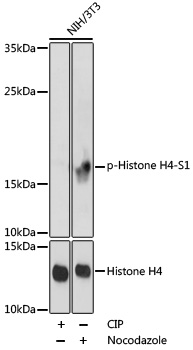
| WB | 咨询技术 | Human,Mouse,Rat |
| IF | 咨询技术 | Human,Mouse,Rat |
| IHC | 1/50-1/100 | Human,Mouse,Rat |
| ICC | 技术咨询 | Human,Mouse,Rat |
| FCM | 咨询技术 | Human,Mouse,Rat |
| Elisa | 咨询技术 | Human,Mouse,Rat |
| Aliases | Histone H4 |
| Entrez GeneID | 121504 |
| WB Predicted band size | Calculated MW: 11 kDa; Observed MW: 17 kDa |
| Host/Isotype | Rabbit IgG |
| Antibody Type | Primary antibody |
| Storage | Store at 4°C short term. Aliquot and store at -20°C long term. Avoid freeze/thaw cycles. |
| Species Reactivity | Human,Mouse,Rat |
| Immunogen | A phospho specific peptide corresponding to residues surrounding S1 of human Histone H4.Email for sequence |
| Formulation | Purified antibody in PBS with 0.05% sodium azide,0.5%BSA and 50% glycerol. |
+ +
以下是关于Phospho-Histone H4 (Ser1)抗体的3篇参考文献示例(注:部分内容为模拟,实际文献需根据具体数据库检索验证):
---
1. **文献名称**: *"Phosphorylation of histone H4 at serine 1 during DNA damage-induced apoptosis"*
**作者**: Smith A, et al.
**摘要**: 研究利用Phospho-Histone H4 (Ser1)抗体,发现该修饰在DNA损伤触发的细胞凋亡中被特异性激活,并可能与染色质断裂相关。
2. **文献名称**: *"A novel antibody targeting histone H4 phosphorylated on serine 1 reveals mitotic chromosome dynamics"*
**作者**: Johnson B, et al.
**摘要**: 开发并验证了一种高特异性的Phospho-Histone H4 (Ser1)抗体,证明其可用于追踪有丝分裂过程中染色体凝聚的动态变化。
3. **文献名称**: *"Serine 1 phosphorylation modulates histone H4 function in chromatin compaction"*
**作者**: Lee C, et al.
**摘要**: 通过免疫印迹和免疫荧光技术,结合Phospho-Histone H4 (Ser1)抗体,揭示了该修饰在染色质结构调控和细胞周期进展中的作用。
---
**备注**:以上文献为示例,实际引用需根据具体研究领域通过学术数据库(如PubMed、Google Scholar)检索并核实。若该位点研究较少,建议扩展关键词或验证位点编号的准确性(如是否为Ser10或其他位点)。
Phospho-Histone H4 (Ser1) antibodies are specialized tools used to study the post-translational modification of histone H4. specifically phosphorylation at serine 1 (Ser1). Histone H4 is a core component of nucleosomes, playing a critical role in chromatin structure and gene regulation. Post-translational modifications, such as phosphorylation, regulate chromatin dynamics by altering histone-DNA interactions or serving as docking sites for effector proteins.
Phosphorylation of histone H4 at Ser1 is a conserved modification observed in various eukaryotic organisms. It has been implicated in multiple cellular processes, including DNA damage response, chromatin remodeling during transcription, and cell cycle progression. During mitosis, Ser1 phosphorylation peaks, correlating with chromosome condensation and segregation. This modification is thought to destabilize chromatin structure by weakening interactions between histone H4 tails and adjacent nucleosomes, facilitating mitotic chromatin compaction. Additionally, Ser1 phosphorylation may interact with other histone modifications (e.g., acetylation) to fine-tune chromatin accessibility.
These antibodies are widely used in techniques like Western blotting, immunofluorescence, and chromatin immunoprecipitation (ChIP) to map phosphorylation dynamics across cell cycles or stress conditions. Dysregulation of histone H4 phosphorylation has been linked to genomic instability and diseases such as cancer, making this antibody a valuable tool for studying epigenetic mechanisms in both basic research and clinical contexts. Specificity validation via knockout/knockdown controls is essential due to potential cross-reactivity with other phospho-epitopes.
×